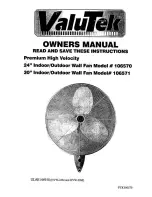
NovAx™
axial flow fan types ACN-ACW ATEX and ACW EX
5
Calculation of startup time
The motor torque can vary within the
below limits and affect the startup time.
5.3 Startup procedure
Refer to the motor manual and the
AirBox technical specifications for
specific information and procedures.
Startup procedure
1. Start the fan.
2. Check that no abnormal noises are
present.
3. Check that the vibration levels are
acceptable.
See section “6.3 Vibration levels”.
4. Check that the fan operates normally
after 30 minutes of operation.
The fans are designed for
continuous operation. The
below kinds of operation may
cause fatigue breaks in the rotors and
endanger people.
•
Operation in stall area, i.e. with
counter pressure that pulsates -
called pump mode
•
Operation with uninterrupted
and repeated starts and stops.
•
Uneven flow velocity through
fans.
Ask Novenco if in doubt.
6. Maintenance
6.1 Before maintenance
Switch off the power and
disconnect the motor cable in
the terminal box, before
beginning work on the rotor and motor.
Remove potential hazards that can cause
explosions in the installation location.
No explosion hazards may be present
when maintenance is performed.
6.2 Cleaning
Clean the fans at least quarterly. The
intervals may have to be adjusted,
dependent on the operation and
operational conditions. Corrosive and
dust filled atmospheres typically reduce
the intervals. Please note that deposits of
dust can be ignited by high surface
temperatures and constitute a safety
risk.
6.3 Vibration levels
Once the installation is complete and for
every 1000 hours of operation the
vibration levels must be checked.
The vibration levels depend on
the installation and the fan
speed. Vibrations have great
effect on the fan life and efficiency.
Constant vibration monitoring
is mandatory for ATEX category
2D fans, i.e. fans in zone 21.
Measure the levels at operational fan
speed, radially at two points with a 90°
offset and at the free shaft end of the
motor. The levels must be within the
below limits.
Vibration level limits at startup
• Motors up to 37 kW
- less than 6.3 mm/s
• Motors over 37 kW
- less than 4.5 mm/s
Fans that exceed the limits usually
require cleaning or balancing of the
rotors. Alternatively, the causes must be
investigated and removed. Refer to
ISO 14694.
For variable speed fans the vibration
level limits are likely to be exceeded at
certain speeds. Continuous operation at
these speeds must be avoided.
6.4 Fan casings
The fan casings require no other
maintenance than ordinary cleaning.
Painted casings should be checked
regularly and kept in good condition.
6.5 Rotors
The rotors are carefully balanced and the
rotor blades are set at precise angles in
the production. The rotors are thereby
optimised for vibration free operation at
the desired operation point with regard
to pressure, airflow and fan speed.
Vibrations that occur in operation may
be due to accumulation of dust and dirt
on the hubs and blades. If vibrations
persist after cleaning, expert assistance
should be called for immediately.
Continued operation with vibrations
shorten the life of the fan and motor
bearings.
6.6 Motor maintenance
Refer to the motor manufacturer’s
documentation and the nameplates for
how to service the motors.
Motor maintenance
• Inspect the motor for wear signs
and damaged parts.
• Clean the motor casing, cooling fan
and motor shell.
• Drain the motor of condensed
water.
• Check supply cables and electric
connections for impairments.
• Check terminal box seals and cable
glands.
• Lubricate bearings
Refer to the motor manual for
service information such as
lubrication intervals, grease
amounts, when to replace bearings
etc.
-
Permanent magnet motors
do
not require lubrication, but may
need replacement of bearings.
-
AC motors
up to size 132 have
lifetime-lubricated bearings.
Motor sizes 160 to 280 require
lubrication according to the
manufacturer’s instructions.
Fans with motor sizes 225 to 280
have nipples on the outer fan
casings. For fans with motor sizes
160 to 200, nipples on the outer
fan casings are optional.
Refer to the motor nameplates for
recommended grease type,
t
s
=
t
s
: Startup time [s]
P
: Rated output of motor [kW]
P
v
: Required power of fan [kW]
n
: Fan speed [RPM]
:
Ratio between the start and
the nominal motor torque
:
Ratio between maximum and
nominal motor torque
I
v
: Polar moment of inertia for fan
[kgm
2
]
I
m
: Polar moment of inertia for
motor [kgm
2
]
M
s
: -15% to +25% of catalogue
value
M
k
: -10% to 0% of catalogue value
0.24
n
2
I
m
I
v
+
(
)
×
×
10
4
P
M
s
M
-------
M
k
M
-------
P
v
P
-----
–
+
×
×
----------------------------------------------------------------
M
s
M
-------
M
k
M
-------































